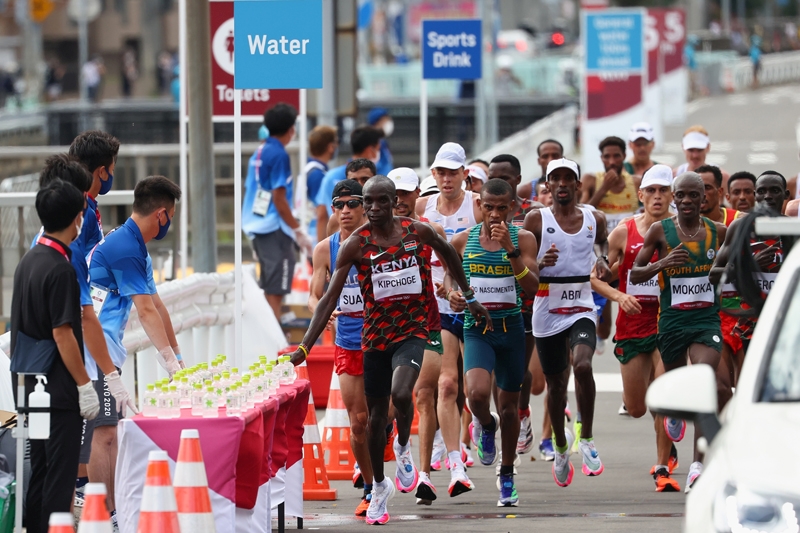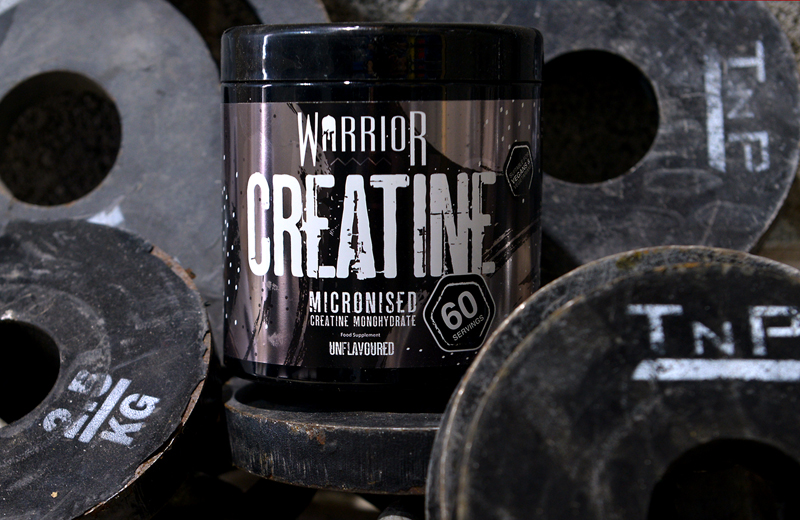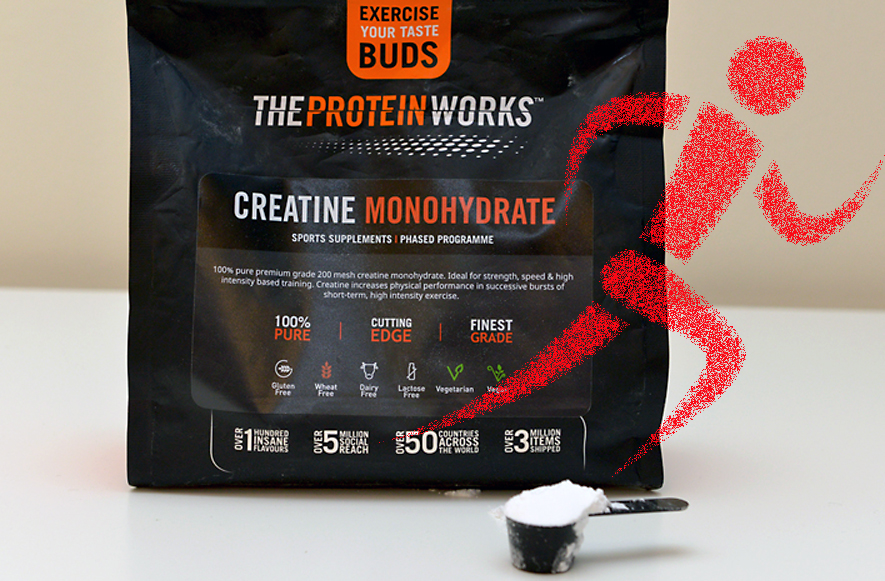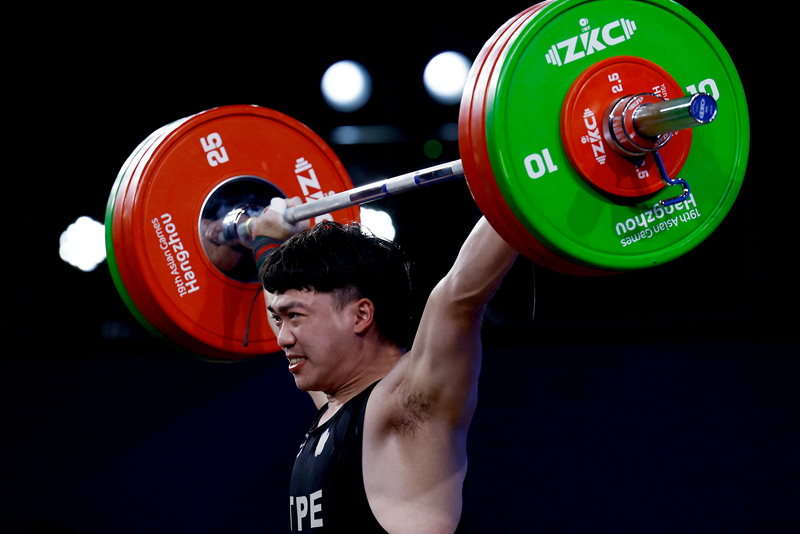You are viewing 1 of your 1 free articles. For unlimited access take a risk-free trial
Hot weather hydration: does your body know best?

Should athletes rely on thirst to guide hydration needs or should they adopt a pre-programmed approach? SPB looks at new evidence
Here in the northern hemisphere, warmer weather is coming, which means proper hydration starts to become an important factor for performance. Unlike many other aspects of sports nutrition however, how much fluid is needed, when and how often it should be consumed is quite a controversial topic. Back in the early 2000s, the conventional advice for athletes was to drink ample fluid during exercise – enough to ensure that any losses in body mass incurred through sweating and respiration were minimal, and certainly less than 2% of body mass (eg 1.5 litres in a 75kg athlete)(1).But this advice came under increasing attack from a number of sports nutritionists and exercise physiologists who believed that the ‘hydrate at all costs’ approach was at best misguided and at worst, downright dangerous – and driven more by the marketing needs of the sports drink industry than the actual science(2). Around the same time, a study on Ironman triathletes (arguably extremely prone to the performance-sapping effects of dehydration) found that fluid losses of 3% of bodyweight (considerably above the ACSM’s guidelines) didn’t result in significant rises in core temperature or any drop in performance(3).
Not too much, not too little
Fast forward 15 years, and the topic of optimum hydration for performance remains far from settled. Getting the balance correct – ie consuming sufficient fluid but not excessive fluid – matters because if you drink too little fluid during exercise you risk becoming dehydrated, but drink too much and you can become hyperhydrated. Both of these outcomes are undesirable as they can impair performance and (in severe cases) can become life threatening. Table 1 lists some of the potential consequences of hypo and hyperhydration.Table 1: Potential consequences of hypo and hyperhydration

So what is the best way of ensuring an optimum fluid balance? Over the years, two schools of thought have emerged:
- Thirst-driven hydration strategy – where athletes drink ample amounts of fluid according to their thirst.
- Programmed hydration strategy – where athletes follow a pre-planned drinking devised to match their expected fluid needs during exercise.
Thirst-driven vs. pre-programmed drinking
Advocates of a thirst-driven approach argue that it prevents hyperhydration and athletes carrying excess weight of superfluous fluid, while still ensuring sufficient intake for performance. It is also easier for athletes to implement (no faffing around remembering to follow a drinking timetable) and more intuitive. Advocates of a pre-programmed approach argue that thirst-driven drinking may not ensure optimum fluid intake, especially given athletes may be significantly dehydrated before thirst becomes apparent (a so-called lag effect), and also that evenly-spaced fluid consumption (eg 100mls every 15 minutes) is less likely to cause gastric distress (tummy bloating and cramps etc).What does the research say? Well, studies suggest that fluid replacement is highly likely to be greater with a pre-programmed approach than with thirst-driven drinking(4). Therefore, programmed drinking might decrease cardiovascular and thermal strain, and perceived exertion more than thirst-driven drinking. However, a greater volume of fluid ingested with pre-programmed drinking may increase the risk of abdominal discomfort(5).
From a health perspective, some researchers still caution as to whether pre-programmed drinking might put athletes at a greater risk for the development of overhydration and low blood sodium (hyponatraemia - serum sodium less than 135mmol/litre) than the use of thirst-driven drinking during prolonged exercise(6). In theory this could happen if athletes consume large amounts of water that is not needed over an extended period of time during an event (ie consuming water that hasn’t been lost through sweating), thus gradually diluting blood sodium levels.
Performance and strategy
That’s the physiology, but what about the performance benefits from a pre-programmed vs. thirst driven drinking strategy? In 2019, researchers carried out a meta-analysis (a powerful type of study that pools the data from all the other previous studies in a subject area) on the impact of these two hydration strategies on exercise performance during exercise of lasting from 60 to 127 minutes in duration(7). The key criteria for these studies were as follows:- Experiments performed under controlled settings
- Exercise lasting for an hour or longer
- Exercise initiated in an fully hydrated state
- Fluid composition matched for electrolytes
- Carbohydrate intake varied matched for exercise
Longer events and new research
At this point, you might assume that thirst-driven drinking is equally as good as pre-programmed drinking during endurance exercise. But what about longer events – event lasting over two hours? It turns out that no study has simultaneously examined the effect of pre-programmed vs. thirst-driven drinking on events over two hours so hydration recommendations regarding those two strategies are, at best, speculative when it comes to prolonged (3+ hours) exercise duration. What is needed is a study to examine longer exercise durations, and this is exactly what a new study on cyclists published in the journal ‘Nutrients’ has investigated(8).In this study, researchers compared the effect of pre-programmed fluid intake (PFI) and thirst-driven fluid intake (TDFI) fluid intake on prolonged cycling performance (five hours duration) and exercise associated muscle cramps (EAMC). Eight well-trained male endurance athletes each completed two separate but identical exercise trials on two separate occasions with the only difference being the two drinking protocols they used during the trials:
- PFI - Water intake was programmed to limit body mass loss to 1%. To ensure this, PFI trial, the amount of water needed to be drunk every hour to maintain this limited mass loss was equally divided into plastic drinking bottles and the participants had 15 minutes to empty each bottle.
- TDFI – The athletes were encouraged to drink freely and according to perceived needs. The same bottle system was used and the water volume consumed was measured every 15 minutes (partially empty bottles were swapped for a full one before they were empty to ensure a constant access to water and to deter the participants from estimating their intakes).
During the trials, measures were also made of skin and rectal temperature, heart rates, perceived exertion, and blood and sweat sodium levels (see figure 1 for an overview of trial protocol). The trials were conducted in a hot environment (30C or 86F) with fans blowing air across the athletes during the trial. Throughout both trials, participants were provided with 1 gram of carbohydrate per kilo of body mass per hour in the form of caffeine-free energy gels. In summary, the trial protocol was chosen to closely mimic the demands of a typical road-cycling race of 5 to 6 hours in duration during hot weather.
Figure 1: Trial protocol

Timeline for the experimental procedures showing when the measurements outlined above were taken. The experiment was divided in three phases, a 5-hour fixed-workload exercise period, a 20 km time-trial and a plantar flexors force measurement protocol to induce cramp.
What they found
The key findings were as follows:- Body mass losses (as a result of reduced hydration levels) averaged around 1.5% in the pre-programmed drinking trial. In the thirst-driven drinking trial however, losses were higher at 2.5 %. More significantly perhaps, the cyclists’ average power output during the 20 km time trial was significantly higher when they followed the programmed drinking protocol (278 watts) compared to the thirst-driven protocol TDFI (263 watts) (see figure 2).
- Despite the better power output and faster times recorded in the 20km time trial when following the programmed drinking protocol, the total performance time, including the breaks to urinate, was similar between conditions (ie the programmed drinking required more and longer pit stops!).
- The prevalence of EAMC of the plantar flexors was similar between the drinking conditions; in other words, the lower levels of hydration in the thirst-driven trial did not increase the risk of muscle cramps.
- The physiological measures and perceptual differences were relatively trivial between conditions.
Figure 2: 20km trial-trial performance and drinking protocol
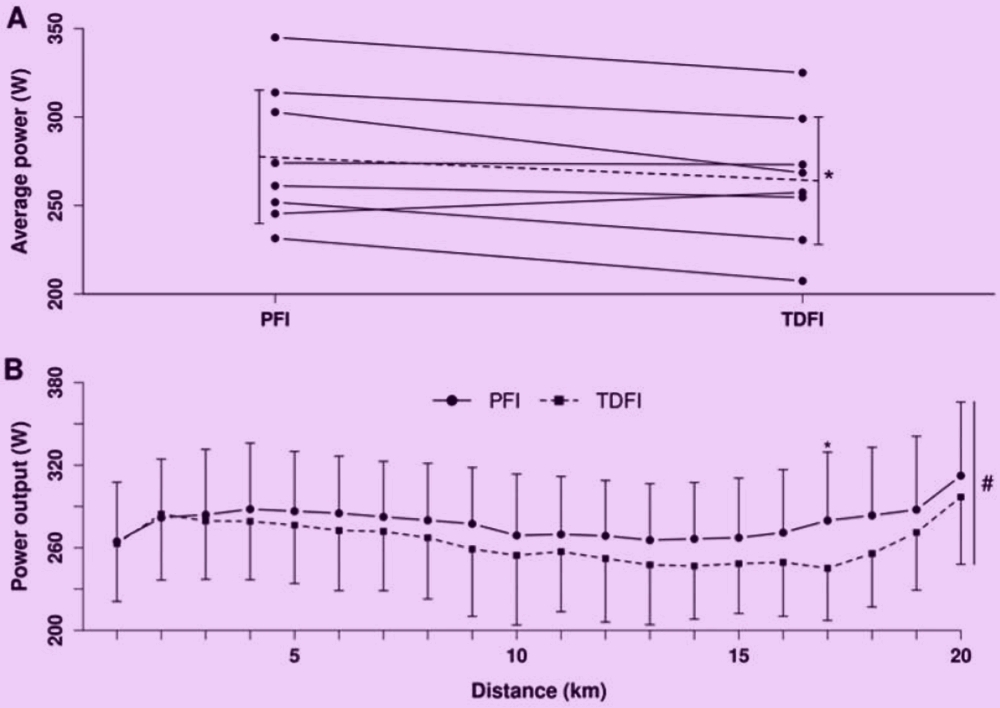
Average power outputs of each participant (A) and changes in power output (B) during the 20 km time-trial for the programmed (PFI) and thirst-driven fluid intake (TDFI) strategies. Dotted line represents the average of the eight participants.
Conclusions and implications for endurance athletes
The researchers concluded that a programmed drinking protocol produced better results in terms of hydration and time-trial performance during a 20km cycling time trial following 5 hours of moderate intensity cycling in a warm environment. These results seem to confirm the established thinking about hydration and performance – namely that when maximal exercise performance is required following prior sub-maximal exercise, fluid intake during that sub-maximal exercise should be sufficient to prevent losses of more than 2% of body mass(9).The interesting thing to note however is that the programmed drinking came at a price – more pee stops and time taken for those stops. When these extra break times were added, overall times to complete the event were no different to when the athletes simply drank according to thirst. Given that most endurance events such as sportives, ultramarathons and triathlons set the clock running at the race start and keep it running until competitors cross the finish line, following a programmed drinking protocol may end up offering no real-world benefits. Indeed, the researchers also commented that if the final section of a race is significantly uphill, the greater fluid losses in a thirst-driven protocol could actually work in an athlete’s favor; that lower body mass means a higher power-to-weight ratio compared to a fully hydrated athlete!
On the other hand, a programmed drinking approach could offer real benefits in cases where an athlete has to undergo extensive rounds or heats on the same day before an event such as a time trial. In this case, being fully hydrated could confer a real advantage as the time taken to complete earlier pit stops through increased fluid intake won’t count against them. Like many aspects of life, the rule of thumb seems to be to choose your strategy according to your event!
References
- ACSM ‘Hydration Consensus Statement’ 2005; forms.acsm.org/15TPC/PDFs/5%20Simons.pdf
- Br J Sports Med 2006;40:567-572
- Br J Sports Med 2006;40:320-325
- Exerc Sport Sci Rev. 1993; 21():297-330
- Med Sci Sports Exerc. 1991 Jul; 23(7):811-7
- Wilderness Environ Med. 2020 Mar; 31(1):50-62
- Sports Med. 2019 Feb; 49(2):221-232
- Nutrients. 2022 Jan; 14(1): 141
- Med Sci Sports Exerc. 2007 Feb; 39(2):377-90
Related Files
Newsletter Sign Up
Testimonials
Dr. Alexandra Fandetti-Robin, Back & Body Chiropractic
Elspeth Cowell MSCh DpodM SRCh HCPC reg
William Hunter, Nuffield Health
Newsletter Sign Up
Coaches Testimonials
Dr. Alexandra Fandetti-Robin, Back & Body Chiropractic
Elspeth Cowell MSCh DpodM SRCh HCPC reg
William Hunter, Nuffield Health
Keep up with latest sports science research and apply it to maximize performance
Today you have the chance to join a group of athletes, and sports coaches/trainers who all have something special in common...
They use the latest research to improve performance for themselves and their clients - both athletes and sports teams - with help from global specialists in the fields of sports science, sports medicine and sports psychology.
They do this by reading Sports Performance Bulletin, an easy-to-digest but serious-minded journal dedicated to high performance sports. SPB offers a wealth of information and insight into the latest research, in an easily-accessible and understood format, along with a wealth of practical recommendations.
*includes 3 coaching manuals
Get Inspired
All the latest techniques and approaches
Sports Performance Bulletin helps dedicated endurance athletes improve their performance. Sense-checking the latest sports science research, and sourcing evidence and case studies to support findings, Sports Performance Bulletin turns proven insights into easily digestible practical advice. Supporting athletes, coaches and professionals who wish to ensure their guidance and programmes are kept right up to date and based on credible science.
